MG note: I have much to say about my trip to India, and I’m doing it with one extremely long post today and two more (shorter) posts in the near future. Collect ’em all.
It’s been three weeks since I’ve returned from India, and it’s taken me about as much time to process my experience there and reacclimate to America. Finding a way to adequately explain it may be something that never happens. In fact, I think that’s the secret about visiting India (and perhaps any place in southern Asia). Your conversations with others who have been there will go like this: “Did you see/experience (fill in the blank)?” “Yes! It was … well, I just don’t know how to explain it to others.” “You never will be able to explain it.” That won’t stop me from trying, of course.
The most adequate one-size-fits-all explanation I can give is that India exists on a plane that is different from the one where all Western culture functions. Sure, English is a common language there, and there are plenty of first-world creature comforts, but time and space function differently in India.
The international departure terminal at the Mumbai airport captured this in a perfect little package. You and your luggage had to push your way through the mob of people that surrounds the doorway (if you don’t have a ticket, you’re not allowed inside the door). Once reaching the door, you have to show your printed ticket to a cop holding an AK-47. No printed ticket? Hopefully your negotiation skills are sharp. I have no doubt bribery would work as well. Once you’re inside the dark, dingy, noisy terminal, there are about a hundred queues of people, each 20 deep or so, that you must wait in to get additional boarding documents and check your luggage. Every line will get plugged up at some point for some unclear reason, and it may take 30 minutes to clear the problem. And there’s nothing you can do about it. The next stop is passport clearance. If your passport agent is in a good mood, you might get through in five minutes. If not, he might spent five minutes staring at you before he even accepts your passport for review. Total crap shoot. There are required patdowns at security, though the experience isn’t unlike the U.S. The gate smells fetid thanks to the Indian-style toilet nearby. I think we got to the airport 2.5 hours ahead of schedule and we barely made our plane. And my traveling companion Sarah and I each had a mild panic attack in the process. When we stepped off the plane in Munich eight hours later, the terminal by comparison is stark, white and silent. I have never in my life been so convinced I had gone deaf.
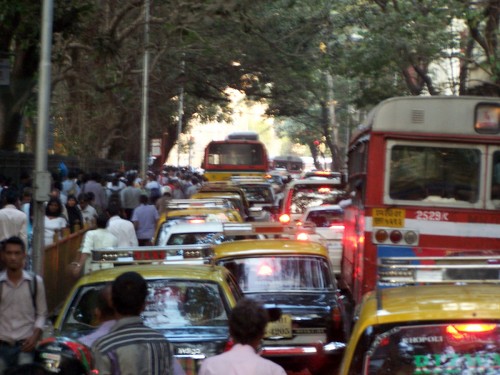 the start of Bombay rush hour. it would take us 2.5 hours to go 12 km.
the start of Bombay rush hour. it would take us 2.5 hours to go 12 km.
The airport scene might have been the most anxiety-inducing situation, but the examples of another time and space were plentiful. There was the traffic in every city and town we visited. Lanes are merely a suggestion, and the traffic moves both ways on both sides of the road. Our drive through Agra was one of the most terrifying experiences I’ve ever had — 40-50 mph going head-first toward oncoming traffic, only to swerve or slam on brakes at the last second. Traffic is a term that covers cars, vans, trucks, rickshaws (motor-powered and otherwise), motorbikes, bicycles, pedestrians, ox-pulled carts, feral dogs, goats, etc. At one point in New Delhi, I saw a man giving a barber-style haircut in a lane of traffic. And of course, it’s completely common to see a half-dozen people on a motorbike and two-dozen people stuffed into and on top of a van designed to hold less than half of that.
And what can you say about the poverty? It is as bad as you probably imagine it is. There are child beggars everywhere (although the guidebooks often caution that these children may not be as poor as they appear to be — instead they’re pawns in scam rings). Because giving to them perpetuates exploitation, your only option is to ignore them. Shack cities sit right next to luxury high rises and Indian-style mansions. One Bombay native told us a story about a man who grew up in the slums but became successful to the point of being a millionaire. But instead of moving to more comfortable accommodations, he continued to live in the slums — under the Indian caste system he saw the slums as his place, and its inhabitants his people, and there was no reason in his mind to leave.
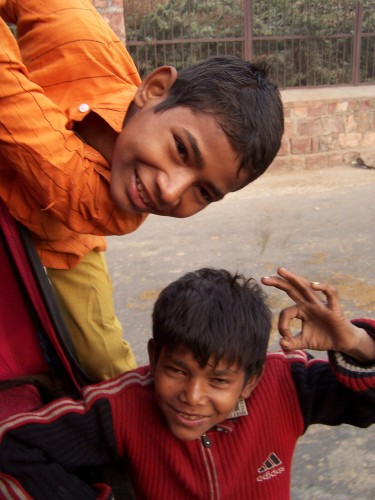 these were some of the few kids who didn’t beg for money or try to sell me junk.
these were some of the few kids who didn’t beg for money or try to sell me junk.
We visited New Delhi about a week after the awful rape that made international news at the beginning of the year. By the time we got there, the demonstrations had ended as cops had blocked off the park land where the youth had been protesting. The only mention we saw of the rape was in a column in the Times of India that insinuated women were asking to be raped with the way they dressed and acted. The demonstrations were by the younger generation, who wanted to protest this awful, patriarchal attitude that pervades the older generations. This is not a bad thing.
 India Gate, where the protests took place
India Gate, where the protests took place
There are some remarkable forts and monuments from the Mughals (more on those later) and gorgeous colonial architecture from the British, but perhaps the most enduring legacy of the British is the ridiculously bureaucratic nature of the country. On our last day, we spent some time at the Elephanta caves — caves adorned with elaborate carvings of Hindu gods that were partially defaced by the Portuguese and British (assholes). You have to pay for a ferry ticket to get to Elephanta Island, then you have to pay a tourism tax after about a half-mile walk toward the caves. After climbing a long stairwell (lined by people selling cheap trinkets and souvenirs), you reach the official ticket booth. Non natives pay a rate that’s about 10 times what Indians pay (fine, fair enough). You’re given a fancy, embossed ticket only to walk two feet and hand the entire, fancy embossed ticket to a guard, never to be seen again. And the bureaucracy is not without corruption. On our first day there, a driver took us around New Delhi to see some sites. Outside the complex that includes the president’s house and governmental buildings, our driver was pulled over. He gets out of the van to talk with the cop, and after about five minutes returns, grabs some rupees, mutters “black money,” and hands it over to the cop.
There are so many other things that I saw that register as “weird” on a Western culture scale but will live only in my mind. By the time something registered as unusual in my mind, it was often gone from sight, leading me to question whether I really even saw it at all. Life of Pi has been one of my favorite books for several years, and my time in India only validates the perception vs. reality theme that runs through it. And I can tell you, I would not be surprised in the least to see an orangutan floating by me on a pile of bananas.
The thing that frustrates me in telling you about all these things is I realize it paints a picture of India that is ugly and backwards. There are actually layers of beauty and wonder woven through that are so, so difficult to capture. India as a whole is complex, paradoxical and disorienting, and it is impossible to capture this in a single description of one person’s experience there. Visiting India with a notion of fully enjoying yourself there is to be disappointed. Instead, go to experience the country, and you will not be disappointed. Would I go again? If the Modern Love Machine insisted on it, I would. If another dear friend ended up getting married there, sure. On my own motivation? Once may be enough. It’s a big, big world out there, and I’m even more determined now than ever to see as much of it as I can.
P.S. A friend of mine posted this video, “A Day in India” from the Perennial Plate, to Twitter soon after I returned. I feel like this does a better job of sharing the beauty of India than I can do with words. Enjoy.
A Day in India from The Perennial Plate on Vimeo.
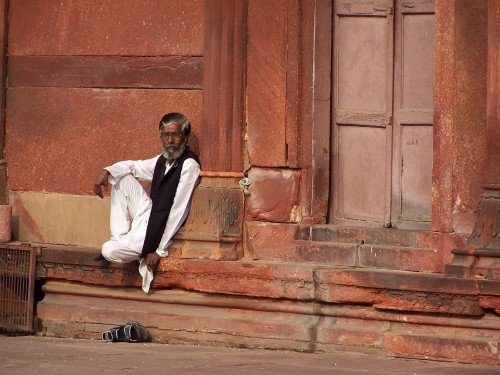

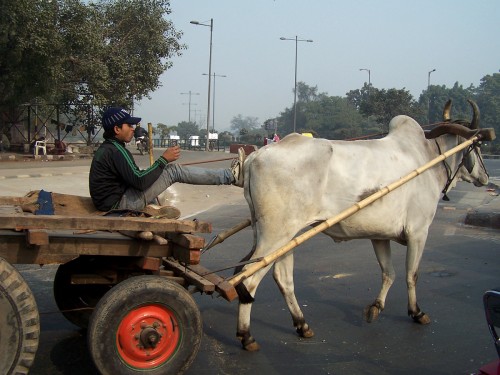
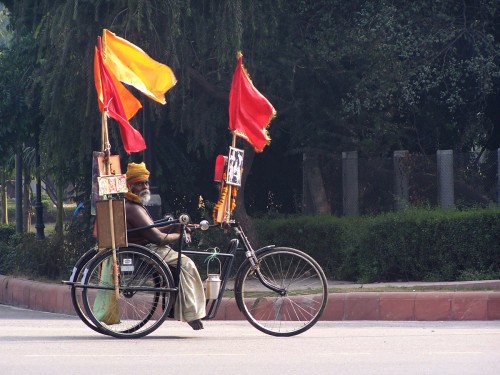
Thanks so much for posting this. I was interested to hear about your experience and I really appreciate this post for its honesty and authenticity. My sister-in-law is from India and this speaks to the India she knows – not the tourist’s India, but a modern India that’s still holding on to so many of its traditions from the past in a way that creates a country almost impossible to describe. The pictures are beautiful as well.
To be fair, we had our share of sanitized, touristy treatments. It’s hard to avoid altogether unless you are spending time with people who actually live there — you tend to stick out like a sore thumb. Thankfully, the bride’s family, who lives in Mumbai, did a lot of the planning for us, so we did at least get some authentic stuff from time to time.
So not to sound like a stalker, but following your photos from your trip was amazing. And after seeing those, and reading this, it just sounds like such a surreal experience. Looking forward to more!
I don’t think I would ever consider you a stalker. Unless you moved in next door unannounced, but I would still be pretty happy about that.